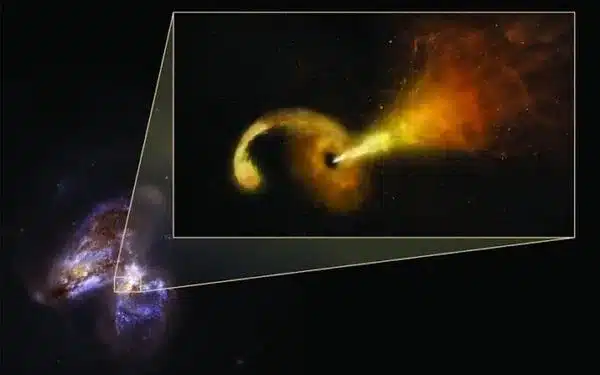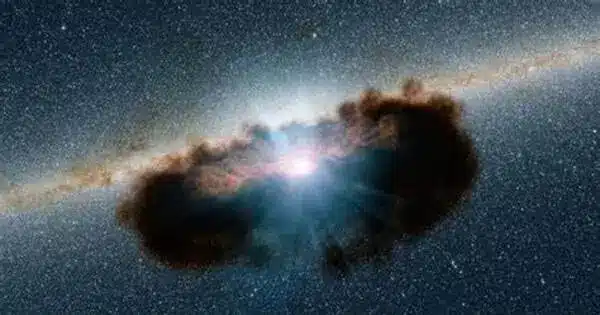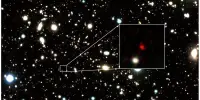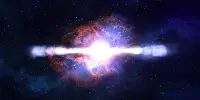Black holes are extremely huge and dense objects in space that can absorb nearby matter, including stars, during a process known as accretion. The rate at which this occurs, however, varies tremendously, and it’s not as simple as saying a black hole eats a certain amount of material every time it passes anything.
A massive burst of X-rays seen by astronomers implies the burning up of material three times the mass of Earth in a black hole. They witnessed a star similar to our Sun being eaten away with each near orbit. The first observation of a Sun-like star being repeatedly disturbed by a low mass black hole opens the door to the discovery of a variety of star and black hole pairings.
In a nearby galaxy, a star similar to our Sun is being slowly devoured by a small but ravenous black hole, losing the equivalent mass of three Earths each time it passes close. The discovery, made by astronomers at the University of Leicester, was published today (7 September) in Nature Astronomy and fills a ‘missing link’ in our understanding of black holes destroying orbiting stars. It alludes to a whole slew of undiscovered stars in the process of being eaten.
The UK Space Agency and the UK Science and Technology Facilities Council (STFC) provided assistance to the team.
This type of object was essentially undetectable until we built this new facility, and soon after it found this completely new, never-before-seen event. Swift is nearly 20 years old and it’s suddenly finding brand new events that we never knew existed.
Dr. Evans
A brilliant X-ray burst appeared to emerge from the center of the nearby galaxy 2MASX J02301709+2836050, around 500 million light-years away from the Milky Way, alerting the researchers to the star. Swift J0230 was discovered the first time it occurred using a new instrument created by scientists for the Neil Gehrels Swift Observatory. They quickly booked further Swift observations of it, discovering that instead of fading as expected, it would flash brightly for 7-10 days before abruptly switching out, a process that repeated roughly every 25 days.
Similar behavior has been observed in what are termed quasi-periodic eruptions and periodic nuclear transients, where a star has material ripped away by a black hole as its orbit takes it close by, but they differ in how often they erupt, and in whether it is in X-rays or optical light that the explosion is predominant. The regularity of Swift J0230’s emissions fell between the two, suggesting that it forms the ‘missing link’ between the two types of outburst.
Using the models proposed for these two types of events as a guide, the scientists determined that the Swift J0230 outburst indicates a star similar to our sun on an elliptical orbit around a low-mass black hole at the galaxy’s center. As the star’s orbit brings it closer to the black hole’s extreme gravitational attraction, material the mass of three Earths gets torn from the star’s atmosphere and heated up as it falls into the black hole. The extreme heat, estimated to be approximately 2 million degrees Celsius, emits a large number of X-rays, which were initially detected by the Swift spacecraft.

“This is the first time we’ve seen a star like our Sun being repeatedly shredded and consumed by a low mass black hole,” said lead author Dr Phil Evans of the University of Leicester School of Physics and Astronomy. So-called’repeated, partial tidal disruption’ episodes are a relatively new discovery, and they appear to be divided into two types: those that occur every few hours, and those that occur every year or so. This new system bridges the gap between the two, and when the numbers are crunched, the types of things involved fall neatly into place as well.”
Dr Rob Eyles-Ferris, who works with Dr Evans on the Swift satellite, recently completed his PhD at Leicester, which included the study of stars being disrupted by black holes. He explains: “In most of the systems we’ve seen in the past the star is completely destroyed. Swift J0230 is an exciting addition to the class of partially-disrupted stars as it shows us that the two classes of these objects already found are really connected, with our new system giving us the missing link.”
“Given that we discovered Swift J0230 within a few months of enabling our new transient-hunting tool, we expect that there are a lot more objects like this out there, waiting to be discovered,” said Dr Kim Page of the University of Leicester, who worked on the data analysis for the study.
Dr. Chris Nixon is a theoretical astrophysicist who recently transferred to the University of Leeds from the University of Leicester. He was in charge of the theoretical understanding of this occurrence. The UK Science and Technology Facilities Council and the Leverhulme Trust are funding his research.
They estimate that the black hole is around 10,000 to 100,000 times the mass of our sun, which is quite small for the supermassive black holes usually found at the centre of galaxies. The black hole at the centre of our own galaxy is thought to be 4 million solar masses, while most are in the region of 100 million solar masses.
It is the first discovery made utilizing the University of Leicester team’s novel transient detector for the Swift satellite, which is running on their computers. An astronomical X-ray transient occurs when an extraordinary event occurs that causes an X-ray burst in a region of the sky where there were previously no X-rays. Despite the extreme events they foretell, these events are difficult to locate, or at least not quickly – which is why this new program was created to search for new sorts of transients in real time.
Dr Evans adds: “This type of object was essentially undetectable until we built this new facility, and soon after it found this completely new, never-before-seen event. Swift is nearly 20 years old and it’s suddenly finding brand new events that we never knew existed. I think it shows that every single time you find a new way of looking at space, you learn something new and find there’s something out there you didn’t know about before.”
“This is yet another exciting discovery from the world-leading Swift mission — a low mass black hole taking ‘bites’ from a Sun-like star whenever it orbits close enough,” said Dr Caroline Harper, Head of Space Science at the UK Space Agency.For many years, the UK Space Agency has collaborated with NASA on this mission; the UK spearheaded the development of hardware for two of the important research instruments, and we supplied financing for the Swift research Data Centre, which we continue to support. Swift’s future contributions to our understanding of gamma ray bursts and the huge events that create them will be greatly appreciated.”
















